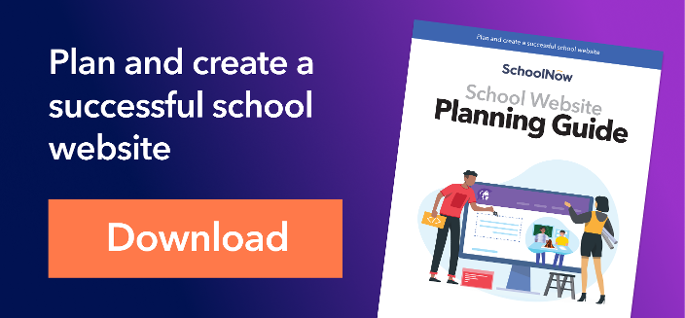Oh how letters from the superintendent these days are getting a lot more attention than ever before, huh? With school plans changing as frequently as Oklahoma weather, emails from your school leaders need to be not only noticed, but effective but clear and concise, so I’m offering up 5 ways to improve email writing for school disruption.
These tips incorporate some of the science of email crafting that is proven to improve engagement with audiences. Put them into practice to improve email communication from your school district leaders, and you’ll increase the open rate, messaging, comprehension and desired results of your emails.
Email, the workhorse of school digital communications, remains a popular channel for your parents. It's a powerful channel for serving up critical, official school information to your parents and other school stakeholders at a time when your school plans need to be especially flexible and your communications clearer than ever.
1. Ponder your subject wording.
First of all, make sure you grab their attention. Spend time on creating a concise, compelling title to put in the subject field. ‘Letter from the Superintendent’, while comprehensive, is so general that some parents may pass over it in their inbox. Granted, given the backdrop of the pandemic, such a broad subject might garner a higher open rate than usual, but subject lines should be specific – virus or no virus, crisis or no crisis.
Simply put, your subject line can make or break your email.
effectiveness.Subject lines like ‘School Calendar Update’ or ‘New Return-to-School Checklist’ are likely to get more attention, for example. The wording in the subject line is important, so be sure to give word choice proper and thorough consideration before settling on the final version. Some email clients offer A/B testing to determine which subject line is more popular. A/B testing gives you a chance to ‘try out’ certain email components with a sample mailing. Learn more about A/B testing in this How to Do A/B Testing Checklist.
2. Tease with preview text.
Another easy way to improve your email effectiveness is to spend some time on crafting sharp preview text. Like the movie trailers at the theater – you remember movie theaters don’t you? – preview text gets people to watch the whole movie. I mean, read the whole email.
Preview text appears under the subject line and serves to reinforce the message or elaborate on it some so your audience can get the gist of your email in the event your subject line doesn’t do the trick.
Consider your preview text as ‘teaser’ copy that sums up or expands on the subject. When writing your tease, try to use words that will create interest and get them to open the email: e.g., 3 important school dates for next week. (NOTE: character length for preview text varies depending on the email client, but it tends to be around 50 characters. Check with your email admin.)
3. Consider your mobile viewers.
Because many of us check our emails regularly via our mobile phones, keep that in mind when your copy starts approaching War and Peace length. News alert: people don’t read long emails. Considering recent email research statistics indicate mobile opens accounted for 46 percent of all email opens, remember brevity is king. Put yourself in the place of an already-time-crunched parent who is reading your email on the move.
There are a couple of things you can do to keep your emails brief, on point and mobile friendly. Assuming you’ve organized your message into succinct points you want to make, break it down for your reader visually by utilizing bullet points or numbers. These signposts are very helpful when delivering multiple support points to your email.
Also, use your email to link to longer-form versions of content when necessary. You’ll likely want to reinforce important emails with web-based content on dedicated web pages like the Update Center or Remote Learning Centers SchoolNow created for many school districts.
4. Perfect (or create) your style.
Times have changed. The days of formal letter writing have gone the way of the corporal punishment and fire drills. Educational jargon or edu speak, a trap many school administrators fall into, is to be avoided at all cost.
Letters from your school leaders are perfect opportunities for establishing or reinforcing your school culture. Be approachable and friendly with your word choice and your school community just might start looking forward to hearing from you.
With the heightened need right now for communications from your school, take this time to evaluate your own style. Go through old emails and take note of recurring tendencies – good and bad. Review and revise your writing; so often we mistake the first draft for the final one, and after further review, realize there were simpler, clearer ways to convey the message.
5. Have a clear desired action.
Sounds obvious, but make sure your desired action is crystal clear. You’re writing that email for a reason, right? So make sure before you set out on that first draft – and certainly before the final – you know precisely what you want the reader to do or learn from it. Each email should have a goal; some will seek an action on the part of the reader, others just informing.
Don’t send emails that create more questions than answers. If there are questions swirling, a Q and A format, however, may not be a bad way to go – if not too lengthy. Any time your message gets long, consider directing the reader to a linked page on your website.
Make email effective for you and easy on your parents
Email, the original digital communications channel for schools, remains the preferred channel for many parents and staff to receive important school information. The same reasons – efficient, easy, a digital permanent record – make it popular for superintendents, principals and other school leaders to use.
Email is also sweet because you have a built-in audience predisposed to receiving your information, so take advantage of that. Don’t sour your parents (and staff) with long, jargon-filled messages camouflaged by a vague subject line and no clue about the content.
Under the easiest of times, parents are on the lookout for information they can use; information that’s pertinent to the day-to-day challenge of getting their children and themselves through another day, week, month and year of school.
During the pandemic, try to make it easy on them by making your emails direct, clear, concise by utilizing the tactics above.
About the author
Marketing director and content strategist for SchoolNow, Jay’s a former school public relations specialist who’s helped businesses, schools and colleges use the power of communications to improve their image, generate support, and optimize relationships. Reach him at jay@schoolnow.com.
.png?width=64&height=63&name=Group%20(4).png)
.png?width=66&height=64&name=Group%20(5).png)
.png?width=56&height=60&name=Group%20(6).png)
.png?width=66&height=52&name=Group%20(7).png)
.png?width=56&height=56&name=Group%20(9).png)
.png?width=59&height=52&name=Group%20(10).png)


